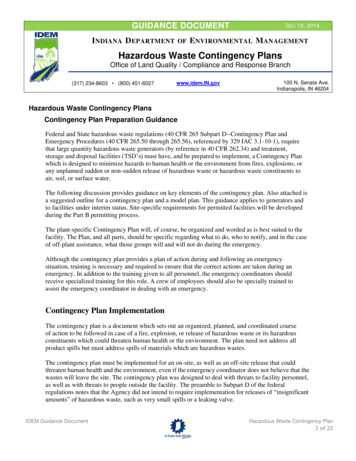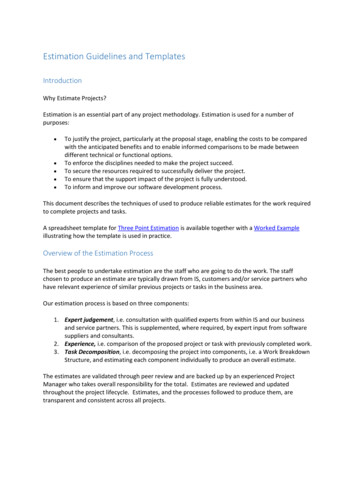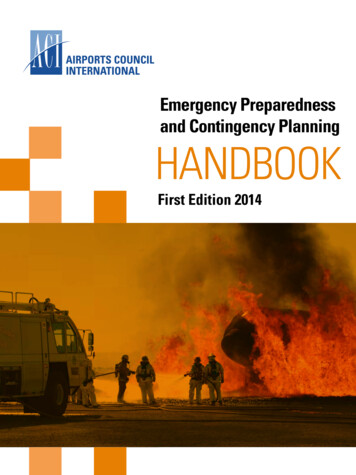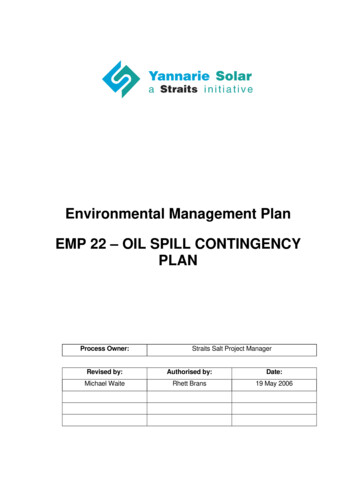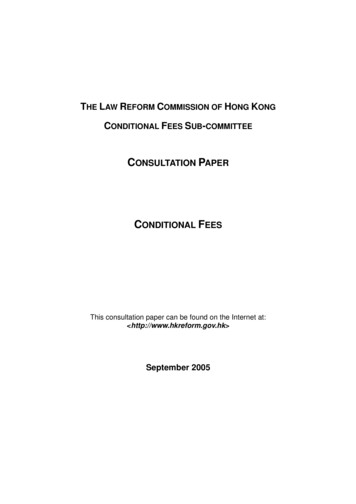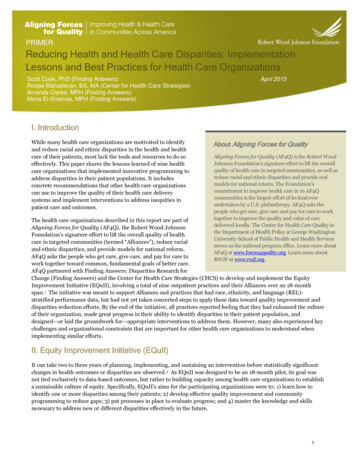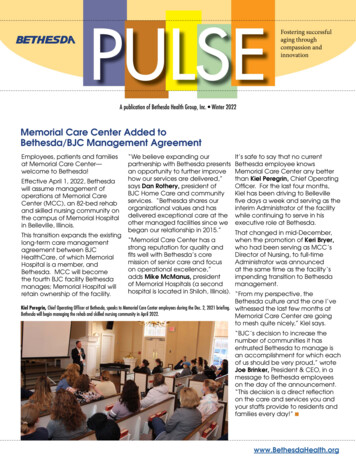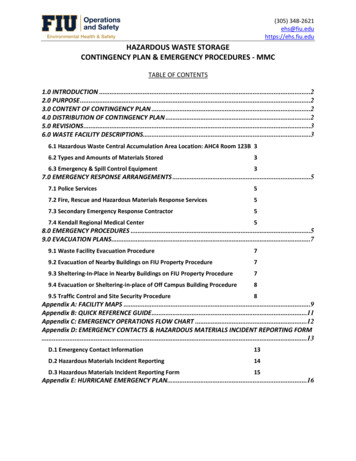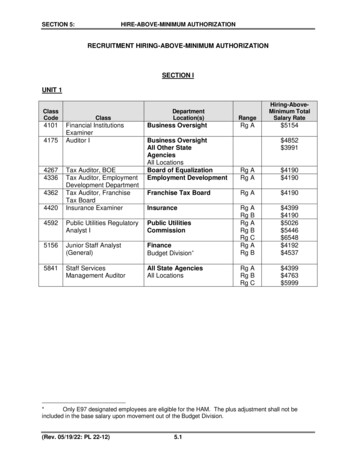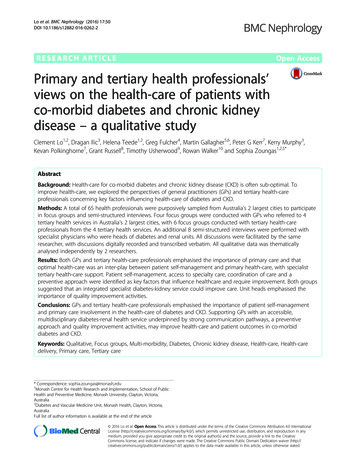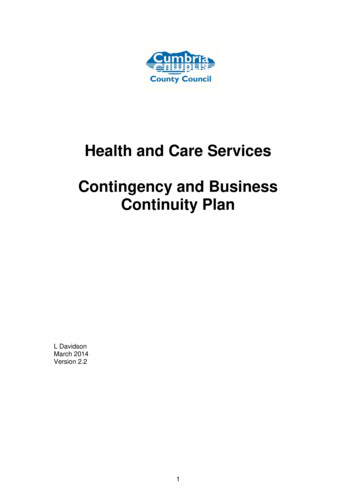
Transcription
ncHealth and Care ServicesContingency and BusinessContinuity PlanL DavidsonMarch 2014Version 2.21
DOCUMENT CONTROLAPPROVAL AND REVIEWOriginal Author:Last Approved By:Lynne DavidsonDirectorate Contingency Planning GroupDate OriginallyPublished:22 December 2011Date of Next Review:March 2015DATEVERSIONNUMBERJune te – Adult andLocal ServicesInclusion eview;inclusion of ActionCardsGeneral review ofLocal ServicesSectionGeneral review ofPlanGeneral review ofPlan to reflect Healthand Care ServicesAGREED vidsonJackie LeechDirectorateContingencyPlanningGroupEmma vidsonEmma JaneGordonLynneDavidsonThe Contingency Plan will be reviewed by the Directorate’s Contingency PlanningGroup after each incident and training exercise.2
CONTENTS PAGE1.2.INTRODUCTION AND BACKGROUND . 4DEFINITIONS . 53.Equality and Diversity . 74.Scope of the Plan . 75.Ownership of the Plan and the Plan review cycle. 76.Corporate Contingency Planning, Review and Reporting Structure. 17.Financial Arrangements. 18.Record Keeping . 19.Emergency Response Register . 110.Staff welfare, health and safety . 111.Resilience Direct. 212.PLAN ACTIVATION AND CALL OUT PROCEDURES. 210.ROLES AND RESPONSIBILITIES. 6A.Key Directorate Contacts. 6B.Welfare Co-ordinator . 6C.County Council Control Centre . 10D.Incident Room. 10E.Welfare Co-ordination Team. 11F.Crisis Support Teams . 12G.Humanitarian Assistance Centres . 14G.Community Support Centre . 14H.Emergency Mortuary Arrangements. 14G.Internal Incident . 154. DEBRIEFING . 155. BUSINESS CONTINUITY MANAGEMENT . 16ESSENTIAL SERVICE PRIORITISATION – BUSINESS CONTINUITY PLANNING 16A.Directorate Recovery Group . 16B.Key to Identifying Priorities for Essential Services. 16C.Priority Scores for Essential Services. 17D.The Priority order of Essential Services/Functions . 19E.Business Continuity Plan . 195. TRAINING and EXERCISING. 356. RECOVERY. 36Appendix A – Health and Care Services Incident Room . 40Appendix B – Incident Log Sheet . 43Appendix C – Emergency Assistance Centres: Staffing / Operation. 44Appendix D – Emergency Assistance Centre Response Kit . 46Appendix E - Checklist of Tasks And Responsibilities . 47Appendix F – Cumbria Care Emergency Plan. 48Appendix H - Pandemic Influenza . 69Appendix I – Supporting People in Emergencies. 70APPENDIX K – ACTION CARD: KEY DIRECTORATE CONTACT. 71APPENDIX J – ACTION CARD: WELFARE CO-ORDINATOR . 73APPENDIX K – ACTION CARD: CRISIS SUPPORT TEAM LEADER . 75APPENDIX I – ACTION CARD: WELFARE CO-ORDINATION TEAM . 77APPENDIX I – ACTION CARD: EMERGENCY ASSSISTANCE CENTRE –WELFARE TEAM LEADER. 79APPENDIX J - HEALTH AND CARE SERVICES - INCIDENT ROOM . 81APPENDIX J - HEALTH AND CARE SERVICES - INCIDENT ROOM . 833
1.INTRODUCTION AND BACKGROUNDThe aim of this plan is to state the response of the Health and Care Services to anyincident which threatens the safety of the community or environment, or disrupts theCouncil’s normal provision of services.Government guidance indicates that top tier local authorities and those with socialcare functions, lead on humanitarian assistance (welfare) during and following anemergency.“Top tier and unitary local authorities are responsible for coordinating welfare supportto affected communities in the event of an emergency social caredepartments are best placed to fulfil the humanitarian assistance function, takinginto account the provisions of the Local Government 2000, Children’s Act 2004 andthe Civil Contingencies Act 2004”HM Government 2006, Humanitarian Assistance in EmergenciesThe Plan is generic and outlines how Health and Care Services will respond to anemergency situation. As emergencies and incidents vary considerably, this planprovides a core set of principles and processes that can be applied to handle a rangeof situations.4
2.DEFINITIONSBusiness ContinuityThe capability of an organisation at strategic, tactical andoperational levels to business disruptions in order tocontinue business operations to an acceptable predetermined level.Category 1 respondersCore responders in an emergency. They include theusual ‘blue light’ emergency services as well as otherssuch as local authorities.Category 2 respondersKey operational responders that act in support ofCategory 1 responders such as utility companies andtransport operators.Civil Contingencies Act2004The Civil Contingences Act 2004 establishes a singleframework for civil protection at the local level,establishing a clear set of roles and responsibilities forlocal responders.Community RiskRegisterEnsure all Category 1 responders have an accurate andshared understanding of the risks they have so thatplanning may be proportionate. The Community RiskRegister is available online on the Council’s website.Control CentreMulti-directorate / agency centre for the County Councilmanagement of any incident – often referred to asCounty Council SILVER. Deals with all requests anddecisions on action to follow by individual servicedirectorates.Crisis Support TeamLocalised Adult Social Care response to an incident, ledby the District Lead.Cumbria ResilienceForum (CRF)The principal mechanism for multi agency co-operationbetween Category 1 and Category 2 responders is viaCumbria Resilience Forum and is chaired by CumbriaPolice.Emergency AssistanceCentreEstablished on a temporary basis during an emergencyto provide accommodation, registration, food and welfarefor evacuees, survivors, friends and families.Major IncidentAn incident, the scale of which requires a full multiagency response. A Major Incident can be declared byany Category 1 responder but should be done so inconsultation with the Police. A decision by the CountyCouncil to declare a Major Incident can only be done bythe Duty Director in consultation with the Police.Maximum TolerablePeriod of Disruption(MTPD)Duration after which an organisation’s viability will beirrevocably threatened if service delivery cannot beresumed.5
Request to Implement“Implement” will be used to request the immediatedeployment of officers and resources in activation of thePlan.Request to Stand By“Stand by” will be used as an early warning to relevantofficers of a situation which might at some later stagerequire a response from the County Council.Request to Stand DownWill be used to signify the phased withdrawal of theCounty Council response.RiskRisk measures the significance of a potential event interms of likelihood and impact.Strategic Co-ordinatingGroup (SCG)Multi agency strategic group, chaired by the Police:often referred to as GOLD.Unusual incidentAn incident which because of its nature or effectsrequires a co-ordinated response by the County Councilin isolation or in support of a limited multi-agencyresponse. An Unusual Incident can be declared by anyCategory 1 responder, who will then provide a controlroom to deal with the incident and invite selectedagencies to attend.Welfare CoordinationTeamMulti agency team responsible for co-ordinating welfaretasks to agencies and to formulate policies.Welfare Co-ordinatorKey role within the Directorate for small scale or in thevery acute phase of an incident, to lead and co-ordinatethe welfare response within a multi agency setting.6
3.Equality and DiversityAs in all areas of work undertaken by the Health and Care Services, therequirements of the spiritual and religious beliefs of service users, the public and ourown staff must be taken into account as far as is practicable. Given that there isimmense diversity between different cultures and religions, general guidance isavailable. An equality impact assessment has been produced to accompany thisplan.4.Scope of the PlanThis plan sets out what action may be taken and services maintained/provided whenan incident takes place which disrupts the work of the Directorate to the extent thatnormal operations cannot be maintained.It is supported by a series of appendices which provide further detail of specificresponsibilities and actions required of the Health and Care Services.5.Ownership of the Plan and the Plan review cycleThis Plan is owned and agreed by the Directorate Management Team and managedand monitored by the Directorate Contingency Planning Group, who will ensure it isreviewed on an annual basis.In addition it will be reviewed following any exercise or incident.7
6.Corporate Contingency Planning, Review and Reporting StructureCabinetScrutiny(on request)(Annually)CorporateContingencyPlanning Group(Quarterly)ExtendedCorporateManagementTeam (Quarterly)Directorate LeadCorporateEmergency PlanningOfficersDirectorateContingencyPlanning ly, asrequired)
7.Financial ArrangementsIn general, the Director of Resources will manage the financial and legal implicationson the County Council as a result of the incident. Staff committing expenditure onbehalf of the Directorate should follow the General Finance Policy of the CountyCouncil which states: In the initial stages of the emergency, life saving activity must take precedenceover the budgetary considerations. However, where possible, significantexpenditure should be authorised by the Emergency Co-ordinator. As soon as possible, a mechanism for authorising and recording expendituremust be established, including the allocation of appropriate cost codes. If the incident can be attributed to a particular site or activity operator, seek, assoon as possible, an agreement that the Company, or their insurers will meetthe incurred expenditure. Where there is any confusion as to the ability to commit expenditure, relevantHealth and Care Services staff will be notified in writing by a member of theDirectorate Management Team.8.Record KeepingThe possibility of legal proceedings after the event must be borne in mind and therecording of data and collection of information should be designed to assist inpreparing the subsequent report on the action taken by the County Council. For thisreason officers should ensure that their principal actions are recorded and retainedfor collation at the end of the incident. It is important that officers log the details ofmessages which are passed personally on the forms provided. The completed formsshould be retained for collation at the end of the incident.9.Emergency Response RegisterStaff who put their contact details forwarded to be included on the EmergencyResponse Register, and are subsequently called out to assist with the response, willbe reimbursed for their time outside normal working hours. Responders shoulddiscuss with their line manager regarding the reimbursement of the time spent.10.Staff welfare, health and safetyStaff at all levels are likely to be placed under more pressure that normal whendealing with and responding to a major incident. Health and Care Services commitsto give a high priority to staff welfare issues whilst also management the immediateimpacts of the incident.If staff have any concerns regarding welfare issues, these should be brought to theattention of their line manager as soon as possible in order that appropriate actioncan be taken.1
11.Resilience DirectThe Directorate has access to the Resilience Direct Extranet. Resilience Direct isused to store key documents relating to emergency response in Cumbria and to postpublic warning messages etc during an emergency.12.PLAN ACTIVATION AND CALL OUT PROCEDURESHow the Plan will be Activated The alert will be received from the Duty Emergency Planning Officer/DutyDirector, by the Key Directorate Contact on behalf of the Directorate. The Key Directorate Contact will undertake the role of Welfare Co-ordinator ornominate an appropriate officer. Once the decision has been taken to activate this plan, the following categorieswill be used to ensure that nominated Officers are kept informed, during anUnusual or Major Incident, whilst avoiding if possible the unnecessarycommitment of personnel and resources:(i)(ii)(iii)Request to “Stand By”.Request to “Implement”.Request to “Stand Down”. “Stand by” will be used as an early warning to relevant officers of a situationwhich might at some later stage require a response from the County Council. “Implement” will be used to request the immediate deployment of officers andresources in activation of the Plan. “Stand down” will be used to signify the phased withdrawal of the CountyCouncil response. The Duty Emergency Planning Officer or Duty Director will notify the Directorateshould the situation change, and will advise the Directorate to review thecurrent activation status.Call Out ProceduresAs is shown in Emergency Response Activation and Call out Procedures diagram, aKey Directorate Contact will be contacted by the Duty Emergency Planning Officer orDuty Assistant Director with as much information as is available at that time and arequest to Stand By or Implement some or all or specified responses.It should be noted that whilst the actual circumstances of an individual incident willdictate how it is handled, all staff are expected to take a full and active part in anyaction required of them, unless there are clear reason why they cannot do so. Whencalled to respond, staff will be expected to cancel appointments and meetings andgive total priority to the work requested.2
A regular check of staff who have agreed to be called out in an emergency(Emergency Response Register) is maintained by the Customer SupportDevelopment Manager. This list will be updated on an annual basis and is kept inthe storage facility in the Incident Room at Health and Care Services and issued toKey Directorate Contacts.3
Diagram 1Emergency Response Activation and Call Out ProceduresIf urgent need forresponse will alertappropriate agencySend Directorate Repto County CouncilControl Centre if onehas been set upDuty EmergencyPlanning OfficerKey DirectorateContactWelfareCo-ordinatorImplement Plan forthis type of incidentand identify welfarearrangements foremergencyassistance centres (ifrequired)District LeadCrisis SupportTeamReceives call fromemergency servicesand briefs KeyDirectorate Contacton nature of incidentand cascade statusUndertakes WelfareCo-ordinator role ornominatesappropriate WelfareCo-ordinatorIf out of hours, notifyCarelineCall out CrisisSupport Team staff *Notify vulnerablesitesEmergency Assistance Centre or othernominated centres* The Key Directorate Contact / Welfare Co-ordinator may call out the Crisis Support Team directly. Crisis Support Teams may not becalled out, depending upon the incident4
Diagram 2Health and Care Services Emergency Response Structure rol RoomChildren’sServicesIncident RoomWelfare Co-ordinatorOtherDirectorates,as appropriateHealth andCare ServicesIncidentRoomWelfareCo-ordinationTeamCrisis SupportTeam eEvacueeEmergencyAssistanceCentreFriends aryHumanitarianAssistanceCentreHospitals
10.ROLES AND RESPONSIBILITIESA.Key Directorate ContactsObtain as much information as possible about the incident including: The nature of the incident (e.g. Fire, flood, etc)Where exactly it has taken placeThe scale of the incident (numbers involved, casualties etc)Telephone number for further contact and subsequent informationLocation and telephone number, if available, of any Centres/facilitiesestablished, and what they areExpected responseAny other relevant information Contact and call out resources as required, including: Other senior managers to assist in the mobilisation of staff and resources Staff as required to attend any Emergency Assistance Centres established(ONLY ON THE REQUEST OF AN EMERGENCY PLANNING OFFICER) Staff to attend other Centres established Staff to open up the Incident Room (if required).The Directorate has identified the following Officers from Directorate ManagementTeam as Key Directorate Contacts: Corporate Director Health and Care ServicesAssistant Director – DisabilityAssistant Director – Older PeopleAssistant Director – Cumbria CareAssistant Director – Health and Well BeingOther Nominated OfficersThe names and telephone numbers of Directorate Emergency Contacts are kept by theKey Contacts and are also contained within the County Council Emergency CommunicationsDirectory.See APPENDIX K – ACTION CARD: KEY DIRECTORATE CONTACT for an Action Cardrelating to the Key Directorate Contact role and the key considerations.B.Welfare Co-ordinatorDuring small scale incidents and prior to the establishment of the Welfare Co-ordinationTeam, an appropriate Welfare Co-ordinator will be appointed by either Health and CareServices or Children’s Services to lead and co-ordinate the welfare response appropriate tothe emergency.The key roles of the welfare co-ordinator are: Liaise with Resilience Unit Duty OfficerLiaise with Crisis Support TeamsAssess the need to convene a Welfare Co-ordination Team6
Establish communication with multi agency welfare partners such as District Council,Police Family Liaison Co-ordinator, Cumbria Partnership Foundation Trust, ClinicalCommissioning Group, NHS England, relevant voluntary agencies.First point of contact for all welfare issues relating to the emergency.Cascade information to Careline if out of hours.Cascade information to vulnerable sites.Maintain log of all actions and decisions taken.This role ensures clarity around the Directorate’s own response in terms of businesscontinuity, and the lead multi agency welfare role.The welfare co-ordinator has full authority to allocate resources, and how the welfareaspects of the Supporting People in Emergencies plan are delivered on behalf of CumbriaCounty Council in conjunction with the Assistant Director representative at the ControlCentre or the County Council representative at Strategic Co-ordinating Group (SCG).The Welfare Co-ordinator can be based at any location as deemed practical by the incident,and will be included in any teleconferences with County Council representatives at StrategicCo-ordination Group.See APPENDIX J – ACTION CARD: WELFARE CO-ORDINATOR for Welfare Co-ordinatorAction Card.7
Welfare Coordinator Activation and Alerting Cascade – Multi AgencyPOLICECCC RU DUTY OFFICERInitially takes on role ofWelfare Coordinator forCCCINITIATE ANY URGENT VOLUNTARY SECTORRESPONSEHEALTH AND CARE SERVICESKEY CONTACTIn consultation with Resilience UnitDuty Officer nominate WelfareCoordinator from H&CSS or CSDirectoratesDistrict LeadWELFARE COORDINATORCrisis SupportTeam(s) (H&CareSand CS)Assess the need to convene aWELFARE COORDINATIONTEAM(physically/virtually)ESTABLISH COMMUNICATION WITH MULTIAGENCY WELFAREPARTNERS (as dictated by the nature and scale of the incident)Children’sServicesKey Contact(If not WC)DistrictCouncilEmergencyLiaisonOfficer(if ESCsopen)Police FamilyLiaisonCoordinator(if fatalities)NHSCumbriaRelevantvoluntaryagencies notalreadyactivated(see above)8
Health and Care Services – Call Out ProceduresIf urgent need for responsewill alert appropriate agenciesDuty EmergencyPlanning OfficerSend Directoraterepresentative to CountyCouncil Control CentreKey DirectorateContactImplement plan appropriate fortype of incident and identifywho will managearrangements for each siteEmergencyAssistance CentresReceives call from emergencyservices and briefs KeyDirectorate Contact on natureof incident and cascade statusstandby/callout/stand downIn consultation with ResilienceUnit (and Director(s) ifappropriate) nominate WelfareCo-ordinator (Health and CareServices or Children’s).Crisis SupportTeamBusiness continuityat baseImplement directoratebusiness continuityarrangementsOther nominatedvenues9
C.County Council Control CentreThe ‘Control Centre’ is the centre of the County Council management of any incident.It is multi-Directorate/agency and is based in the Control Room in Fire HQ at Penrith.Access is limited to specific managers, (plus their secretarial/administrative support),nominated by individual Directorates and/or agencies, (depending upon the specificincident), with each being allocated a work area, including telephones and computeraccess.The Control Centre is the place to which all requests and/or queries are routed, eitherby senior managers or the public/partner agencies. The managers staffing theCentre will make decisions, based on information received, as to the next stages ofaction to follow. This may include requesting specific information or action to beundertaken via the Directorate ‘Incident Room’, (see below), or liaison with otherDirectorates/Agencies to agree the action required and clarify responsibilities.The lead officer at the Control Centre will need to ensure that any specific printeddocumentation and documents stored at the Control Centre for the sole use of Healthand Care Services are kept up to date.Health and Care Services managers staffing the Control Centre must maintaindetailed logs of all activities. Specific stationery will be available in the Control Centrefor this purpose.D.Incident RoomThe ‘Incident Room’ is the centre of the Health and Care Services management andco-ordination of any incident. It is most likely to be based in the Conference Room inthe Headquarters building on Portland Square, Carlisle, but in exceptionalcircumstances may be based in alternative accommodation.Requests forinformation and/or action to be taken by the Directorate will be managed through theIncident Room.Notification of an incident and the requirement to set up the Incident Room will comevia the Key Directorate Contact, Corporate Director of Health and Care Services or arepresentative, following notification of an incident. In the case of notification, anyprior booking for the Conference Room will be cancelled and staff will be expected torelocate to the room immediately.The people who will probably be required to staff the Incident Room will be; Representative from Directorate Management TeamSecretarial support to interrogate Health and Care Services client recordsAdministrative supportRepresentative of Social CareRepresentative of Cumbria CareRepresentative from Public HealthHealth and Safety ManagerRepresentative of the Contracts SectionOther relevant managers as necessary10
A lead manager should be appointed for the Incident Room who will: Receive handover from Welfare Co-ordinator.Establish contact with the County Council Control Centre.Establish contact with the Crisis Support Team/s.Establish contact with any relevant providers.Ensure the maintenance of detailed logs of all activities.Ensure sufficient staff are available within the Centre to operateOrganise staff rotas.effectively.These staff will have the ability to call on any other relevant staff and partner/provideragencies to support action required depending on the incident being dealt with. Itmay also require staff to work outside of their normal contracted work on a temporarybasis to support the situation.These staff will be expected to keep a detailed log of all activities, including phonecalls received and made; requests for staff; partners/providers contacted andresponse received; funding expended and/or committed, etc. These logs will becollected at the end of any incident, used for debrief and to provide evidence ofactivity. They will be stored in Headquarters and be available for any queriesfollowing the incident.Full details of the facilities available for use in an emergency are provided inAppendix A – Health and Care Services Incident Room as is how to arrange accessto the facilities.When each Incident Room is closed down at the end of an emergency this store willbe replenished to ensure it is ready for the next incident. When specific items areupdated as part of the routine revising of documents, forms, etc, the old version mustalso be replaced in the store.E.Welfare Co-ordination TeamThe Director of Health and Care Services will establish and Chair the WelfareCoordination Team. The Directorate will also provide secretariat for the Team.The Welfare Coordination Team will report to the Strategic (then subsequently theRecovery) Coordinating Group.The following agencies will be represented on the Welfare Co-ordination Team: Health and Care ServicesPolice.Children’s ServicesCumbria Partnership Foundation Trust / Clinical Commissioning GroupHealth Protection AgencyPublic HealthRepresentatives from the responding voluntary agencies e.g. ChurchesTogether in Cumbria, WRVS, British Red Cross, The Samaritans.District Council (for the area(s) in which the emergency has occurred).Resilience UnitOther agencies (co-opted with the agreement of the Team).11
The Welfare Co-ordination Team will meet at regular intervals throughout theemergency in order to formulate policy concerning the provision of welfare.See APPENDIX I – ACTION CARD: WELFARE CO-ORDINATION TEAM WelfareCo-ordination Team Action Card.F.Crisis Support Teams‘Crisis Support Teams’ are the localised response to an incident.Where the Key Directorate Contact / Welfare Co-ordinator considers that the CrisisSupport Team should be activated and convened, it will be the responsibility of theDistrict Lead (or deputy) to gather the appropriate representatives together.These will include: District LeadTeams Manager(s)District Support Team ManagerLocality Support ManagerCumbria Care Operations ManagerRepresentative from Children’s ServicesThey will liaise with, or may even be based together with the other relevant agencies,depending on the specific circumstances of the incident.Crisis Support Teams will be led by Health and Care Services staff (or Children’sServices if more appropriate) but may be multi-agency and include specific agencies,such as Churches Together, Cumbria Fire and Rescue, Cumbria Police, Samaritansand the Salvation Army. The Team/s may be operating in different locationsdepending upon the incident.The Crisis Support Team will be led by the District Lead, and will: Appoint Emergency Assistance Centre Lead Manager for each CentreestablishedOrganise, oversee and support all staff involved in the welfare response at thelocal level.Establish contact with the Incident Room and give regular updatesOrganise staff rotas in the Centres establishedRaise any potential and actual problems with the Incident Room, or WelfareCo-ordinator, as soon as possible.Maintain a detailed log of all actions taken during the incident and ensure theselogs are transferred to the Incident Room at the end of the Incident.Record any lessons from the response and feed into the main incident debriefUndertake business continuity management for priority services within theDistrict.It will be necessary for detailed logs to be maintained of all actions taken during theincident. These logs will be stored in Headquarters along with the logs from theIncident Room.12
The County Council as a whole supports the District
Health and Care Services Contingency and Business Continuity Plan L Davidson March 2014 Version 2.2 . 2 DOCUMENT CONTROL APPROVAL AND REVIEW Original Author: Lynne Davidson Last Approved By: Directorate Contingency Planning Group Date Originally Published: 22 December 2011 Date of Next Review: March 2015 DATE VERSION
